In order to understand the attributes of asymmetric waveforms, it’s important to clarify the differences between DC Offset and Asymmetry …
Waveform Basics
A waveform consists of both a Positive and Negative side, separated by a center (X) axis or “Baseline.” This Baseline represents Zero (∞) amplitude as displayed on the (Y) axis. The center portion of the waveform that is anchored to the Baseline may be referred to as the mean amplitude.
DC Offset
DC Offset occurs when the mean amplitude of a waveform is off the center axis due to differing amounts of the signal shifting to the positive or negative side of the waveform.
One common cause of this shift is when faulty electronics insert a DC current into the signal. This abnormality can be corrected in most file based editing applications and DAW’s. Left uncorrected, audio with DC Offset will exhibit compromised dynamic range and a loss of headroom.
Notice the displacement of the mean amplitude:
The same clip after applying DC Offset correction. Also, notice the preexisting placement of (+/-) energy:
Asymmetry
Unlike waveforms that indicate DC Offset, Asymmetric waveform’s mean amplitude will reside on the center axis. However the representations of positive and negative amplitude (energy) will be disproportionate. This can inhibit the amount of gain that can be safely applied to the audio.
In fact, the elevated side of a waveform will tap the target ceiling before it’s counterpart resulting in possible distortion and the loss of headroom.
High-pass filters, and aggressive low-end processing are common causes of asymmetric waveforms. Adding gain to asymmetric waveforms will further intensify the disproportionate placement of energy.
In this example I applied a high-pass filter resulting in asymmetry:
Broadcast Chains
Broadcast engineers closely monitor positive to negative energy distribution as their audio passes through various stages of processing and transmission. Proper symmetry aides in the ability to process a signal more effectively downstream. In essence uniform gain improves clarity and maximizes loudness.
Podcasts
In spoken word – symmetry allows the voice to ride higher in the mix with a lower risk of distortion. Since many Podcast Producers will be adding gain to their mastered audio when loudness normalizing to targets, the benefits of symmetric waveforms are obvious.
If an audio clip’s waveform(s) are asymmetric and the audio exhibits audible distortion and/or a loss of headroom, a Phase Rotator can be used to reestablish proper symmetry.
Below is a segment lifted from a distributed Podcast (full zoom out). Notice the lack of symmetry, with the positive side of the waveform limited much more aggressively than the negative:
The same clip after Phase Rotation:
(I processed the clip above using the Adaptive Phase Rotation option located in iZotope’s RX 4 Advanced Channel Ops module.)
In Conclusion
Please note that asymmetric waveforms are not necessarily bad. In fact the human voice (most notably male) is often asymmetric by nature. If your audio is well recorded, properly processed, and pleasing to the ear … there’s really no need to attempt to correct any indication of asymmetry.
However if you are noticing abnormal displacement of energy, it may be worth looking into. My suggestion would be to evaluate your workflow and determine possible causes. Listen carefully for any indication of distortion. Often a slight EQ tweak or a console setting modification is all that may be necessary to make noticeable (audible) improvements to your audio.
-paul.
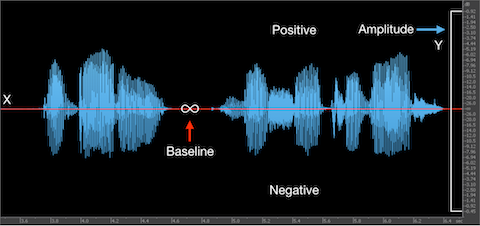
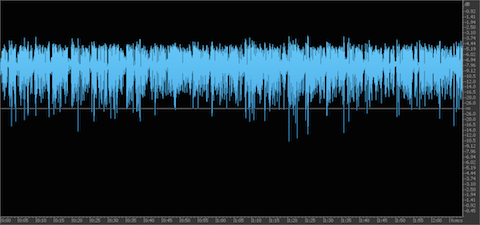
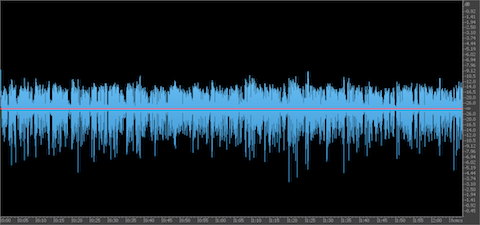
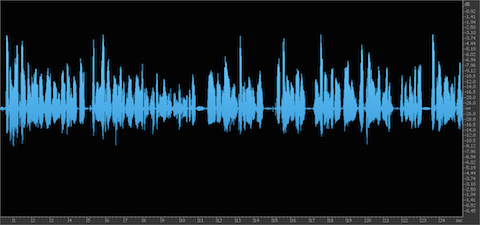
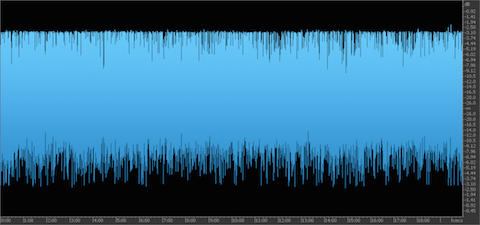
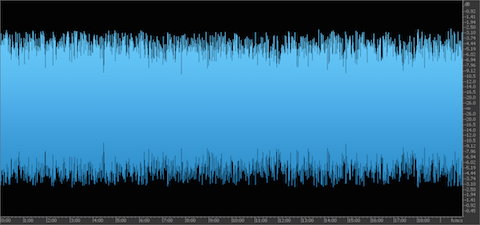
Very interesting indeed, I’ve seen this phenomenon myself sometimes but never knew the reason why. I’ll have to have a fiddle with the high-pass EQ and perhaps try speaking in a falsetto voice 🙂
I’ll definitely have a look into the phase rotate thing though. You’ve really peaked my interest; thanks.
Richard,
Cool. What’s interesting is if the audio in question is pushed hard and suffers from compromised headroom – you can appreciate the benefits of Phase Rotation very easily.
Analyze the source file and note the amount of available headroom. Apply Phase Rotation, and re-analyze. You should see a difference.
Always good to discuss this stuff with you. 😉
-paul.
Paul, I’ll certainly give it a go and thanks for posting such great stuff, just down my alley. Keep up the great work. Richard
You’re welcome, Richard …
-paul.
Paul, Thanks for this! Over the last little bit I found that whenever I used EQ, I ended up with some pretty extreme asymmetry. Turns out I was applying a pretty aggressive high pass filter as a matter of course like so many recommend to eliminate unnecessary low-end energy. Looks like I may just skip the high-pass filter for now!
Hi Curtis,
You’re welcome.
Try rolling off at 50 or 60Hz. In most cases this will serve the purpose in terms of eliminating problematic low-end frequency activity.
Note the use of high-pass/low-pass filters serve a secondary purpose: perceptual encoding (such as MP3) filters out frequency activity that is outside of the normal frequency range that we as humans are capable of hearing. When you supply the encoder with a sort of limited frequency range source, encoding will benefit. In essence any bits the codec/encoder is designed to ignore will be absent.
-paul.
Cool thanks for the tips, I always wandered why some waveforms look like that and really wanted to know why.
You’re welcome.
-paul.
Dear Admin I wolud love to thank you realy for such a wonderfull topic, but I have a question here lets say I am EQing a male VO by cutting below 50~60Hz to avoid missing with the waveform symmetry, so what would be a proper Q curve would you recommend, like a brickwall qurve would be called agressive?
Thank you in advance.
You’re welcome.
I would suggest looking into a Linear Phase EQ. This type of EQ will allow you to tweak the curve without introducing asymmetry. Note it will not correct previously existing asymmetric anomolies..
Good luck.
-paul.
Thank you Paul for your quick reply realy apreciated, so appling adaptive phase rotation before and after EQing, is that the right thing to do?
Happy to help. You want to apply Adaptive Phase Rotation after any processing that may cause asymmetry. If you use a linear phase EQ, the processing order shouldn’t matter.
I find this concept to be especially important when preparing audio for Internet/Mobile distribution, where in most cases a fairly significant amount of added gain may be necessary in order to meet a suitable Integrated Loudness target. The Phase Rotation optimizes headroom and helps minimize the necessity for excessive limiting.
I tweeted this a few days ago. The displayed documentation contains additional information.
https://twitter.com/produceNewMedia/status/807587184492560384
-paul.
Thanks for this very informative article
You’re welcome Oliver.
-paul.